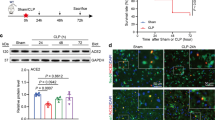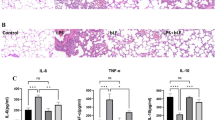Abstract
Sepsis is a big health problem and one of the most common causes of acute lung injury (ALI) leading to high mortality. Pro-resolving mediators play an important role in abrogating the inflammation and promoting tissue homeostasis restoration. ALI treatment is still a clinical health problem, so new therapies are needed. Here, we evaluated the effect of photobiomodulation treatment on the resolution process of ALI induced by lipopolysaccharide (LPS). Male Balb/c mice were submitted to LPS (ip) or vehicle and irradiated or not with light emitting diode (LED) 2 and 6 h after LPS or vehicle injection, and the parameters were investigated 3 and 7 days after the injections. Our results showed that after 3 days of LED treatment the blood and bronchoalveolar lavage (BAL) cells as well as interleukins (IL) including IL-6 and IL-17 were reduced. No differences were observed in the bone marrow cells, tracheal reactivity, and lipoxin A4 and resolvin E2. Indeed, after 7 days of LED treatment the bone marrow cells, lymphocytes, and lipoxin A4 were increased, while IL-6, IL-17, and IL-10 were decreased. No differences were observed in the blood cells and tracheal reactivity. Thus, our results showed that LED treatment attenuated ALI induced by sepsis by modulating the cell mobilization from their reserve compartments. In addition, we also showed later effects of the LED up to 7 days after the treatment. This study proposes photobiomodulation as therapeutic adjuvant to treat ALI.





Similar content being viewed by others
References
Abraham E, Matthay MA, Dinarello CA, Vincent JL, Cohen J, Opal SM et al (2000) Consensus conference definitions for sepsis, septic shock, acute lung injury, and acute respiratory distress syndrome: time for a reevaluation. Crit Care Med 28:232–235
Barreto MFC, Gomes Dellaroza MS, Kerbauy G, Grion CMC (2016) Sepsis in a university hospital: a prospective study for the cost analysis of patient’s hospitalization. Rev Esc Enferm USP 50:299–305
Rao MH, Muralidhar A, Reddy AKS (2014) Acute respiratory distress syndrome. J Clin Sci Res 3:114–134
Fujii M, Miyagi Y, Bessho R, Nitta T, Ochi M, Shimizu K (2010) Effect of a neutrophil elastase inhibitor on acute lung injury after cardiopulmonary bypass. Interact Cardiovasc Thorac Surg 6:859–862
Wyche K, Wang S, Griendling K, Dikalov S, Austin H, Rao S, Fink B, Harrison D, Zafari A (2004) C242T CYBA polymorphism of the NADPH oxidase is associated with reduced respiratory burst in human neutrophils. Hypertenson 43:1246–1251
Moss M, Manino DM (2002) Race and gender differences in acute respiratory distress syndrome deaths in the United States: an analysis of multiple cause mortality data. Crit Care Med 30:1679–1685
Miller E, Cohen A, Nagao S, Griffith D, Maunder R, Martin T, Weiner-Kronish J, Sticherling M, Christophers E, Matthay M (1992) Elevated levels of NAP-1/Interleukin-8 are present in the airspaces of patients with the adult respiratory distress syndrome and are associated with increased mortality. All AJRCCM Issues 146:2
Dalli J, Serhan CN (2012) Specific lipid mediator signatures of human phagocytes: microparticles stimulate macrophage efferocytosis and pro-resolving mediators. Blood 120:60–72
Serhan CN, Hong S, Gronert K et al (2002) Resolvins: a family of bioactive products of omega-3 fatty acid transformation circuits initiated by aspirin treatment that counter proinflammation signals. J Exp Med 196:1025–1037
Rowley AF, Lloyd-Evans P, Barrow SE, Serhan CN (1994) Lipoxin biosynthesis by trout macrophages involves the formation of epoxide intermediates. Biochemistry 33:856–863
Fredman G, Serhan CN (2011) Specialized proresolving mediator targets for RvE1 and RvD1 in peripheral blood and mechanisms of resolution. Biochem J 437:185–197
Serhan CN (2017) Treating inflammation and infection in the 21st century: new hints from decoding resolution mediators and mechanisms. FASEB J 31:000–000
Serhan CN, Chiang N, Dalli J, Levy BD (2015) Lipid mediators in the resolution of inflammation. Cold Spring Harb Perspect Biol 7(2)
Serhan CN, Clish CB, Brannon J et al (2000) Novel functional sets of lipid-derived mediators with antiinflammatory actions generated from omega-3 fatty acids via cyclooxygenase 2-nonsteroidal antiinflammatory drugs and transcellular processing. J Exp Med 192:1197–1204
Serhan CN, Hong S, Gronert K, Colgan SP, Devchand PR, Mirick G, Moussignac RL (2002) Resolvins: a family of bioactive products of omega-3 fatty acid transformation circuits initiated by aspirin treatment that counter proinflammation signals. J Exp Med 196:1025–1037
Serhan CN (2010) Novel lipid mediators and resolution mechanisms in acute inflammation: to resolve or not? Am J Pathol 177:1576–1591
Eickmeier O, Seki H, Haworth O et al (2012) Aspirin-triggered resolvin D1 reduces mucosal inflammation and promotes resolution in a murine model of acute lung injury. Mucosal Immunol 6:256–266
Wang B, Gong X, Wan JY et al (2011) Resolvin D1 protects mice from LPS-induced acute lung injury. Pulm Pharmacol Ther 24:434–441
Kasuga K, Yang R, Porter TF et al (2008) Rapid appearance of resolvin precursors in inflammatory exudates: novel mechanisms in resolution. J Immunol 181:8677–8687
Standiford TJ, Ward PA (2015) Therapeutic targeting of acute lung injury and acute respiratory distress syndrome. Transl Res 167(1):183–191
Petroni RC et al (2015) Hypertonic saline (NaCl 7.5%) reduces LPS-induced acute lung injury in rats. Inflammation 38:2026–2035
Ruthman CA, Festic E (2015) Emerging therapies for the prevention of acute respiratory distress syndrome. Ther Adv Respir Dis 9:173–187
Sharp C et al (2015) Advances in understanding of the pathogenesis of acute respiratory distress syndrome. Respiration 89:420–434
Miranda da Silva C et al (2015) Low level laser therapy reduces the development of lung inflammation induced by formaldehyde exposure. PLoS One 16:10–11
Silva Macedo R et al (2016) Photobiomodulation therapy decreases oxidative stress in the lung tissue after formaldehyde exposure: role of oxidant/antioxidant enzymes. Mediat Inflamm 2016:9303126
Landyshev I et al (2002) Efficacy of low-intensity irradiation and sodium nedocromil in the complex treatment of patients with bronchial asthma. Ter Arkh 74:25–28
Aimbire F et al (2006) Low level laser therapy partially restores trachea muscle relaxation response in rats with tumor necrosis factor alpha-mediated smooth airway muscle dysfunction. Lasers Surg Med 38:773–778
Oliveira MC et al (2014) Low level laser therapy reduces acute lung inflammation in a model of pulmonary and extrapulmonary LPS-induced ARDS. J Photochem Photobiol B 4:57–63
Silva VR et al (2014) Low-level laser therapy inhibits bronchoconstriction, Th2 inflammation and airway remodeling in allergic asthma. Respir Physiol Neurobiol 194:37–48
Goes Costa S, Barioni E, Ignácio A, Albuquerque J, Saraiva ON, Pavani C, Vitoretti L, Damazo S, Farsky S, Lino-dos-Santos-Franco A Beneficial effects of red light-emitting diode treatment in experimental model of acute lung injury induced by sepsis. Sci Rep 7:2017, 12670
Schapochnik A, da Silva MR, Leal MP, Esteves J, Hebeda CB, Sandri S, de Fátima Teixeira da Silva D, Farsky SHP, Marcos RL, Lino-dos-Santos-Franco A (2018) Vitamin D treatment abrogates the inflammatory response in paraquat-induced lung fibrosis. Toxicol Appl Pharmacol 355:60–67
Kim WY, Hong SH (2016) Sepsis and acute respiratory distress syndrome: recent update. Tuberc Respir Dis 79:53–57
LI JT, Melton AC, SU G, Hamm DE, Lafemina M, Howard J et al (2015) Unexpected role for adaptive αβTH17 cells in acute respiratory distress syndrome. J Immunol 195:87–95
Oliveira MCJR, Greiffo FR, Rigonato-oliveira NC, Custódio RW, Silva VR, Damaceno-Rodrigues NR et al (2014) Low level laser therapy reduces acute lung inflammation in a model of pulmonary and extrapulmonary LPS-induced ARDS. J Photochem Photobiol B 4:57–63
Chen C, Shi L, Li Y, Wang X, Yang S (2016) Disease-specific dynamic biomarkers selected by integrating inflammatory mediators with clinical informatics in ARDS patients with severe pneumonia. Cell Biol Toxicol 32:169–184
Reylly JP, Anderson BJ, Hudock KM, Dunn TG, Kazi A, Tommasini A et al (2016) Neutropenic sepsis in associated with distinct clinical and biological characteristics: a cohort study of severe sepsis. Crit Care 20:222–231
Mesquida M, Leszcynska V, Adán A (2014) Interleukin-6 blockade in ocular inflammatory diseases. J Transl Immunol 176:301–309
Normanton M, Marti LC (2013) Current data on IL-17 and Th17 cells and implications for graft versus host disease. Einstein 11:237–246
Burnham EL, Janssen WJ, Riches DWH, Moss M, Downey GP (2014) The fibroproliferative response in acute respiratory distress syndrome: mechanisms and clinical significance. Eur Respir J 43:276–285
Ferretti S, Bonneau O, Dubois GR, Jones CE, Trifilieff A (2003) IL-17, produced by lymphocytes and neutrophils is necessary for lipopolysaccharide-induced airway neutrophilia: IL-15 as a possible trigger. J Immunol 170:2106–2112
Basil MC, Levy BD (2016) Specialized pro-resolving mediators: endogenous regulators of infection and inflammation. Nat Rev Immunol 16:51–67
Funding
This study was sponsored by Fundação de Amparo à Pesquisa do Estado de São Paulo (FAPESP 2017/06444–9).
Author information
Authors and Affiliations
Corresponding author
Ethics declarations
Competing interests
The authors declare that there are no conflicts of interest.
Rights and permissions
About this article
Cite this article
da-Palma-Cruz, M., da Silva, R.F., Monteiro, D. et al. Photobiomodulation modulates the resolution of inflammation during acute lung injury induced by sepsis. Lasers Med Sci 34, 191–199 (2019). https://doi.org/10.1007/s10103-018-2688-1
Received:
Accepted:
Published:
Issue Date:
DOI: https://doi.org/10.1007/s10103-018-2688-1




